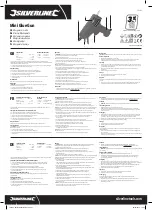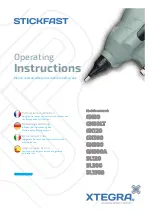
--- 13 ---
Fig. 7
The air pressure on the upper surface of the Exhaust Valve [4] is
released, and the exhaust valve is pushed upward by the air pressure
within the cylinder. This opens the Exhaust Vent [5], and the air pressure
in the cylinder and the left-side surface of the feed piston are discharged
from the nailer.
Air pressure is discharged from the upper end of the
cylinder, and the cylinder is pushed upward by the air
pressure on the lower surfaces of the flanges and the
force of the Cylinder Spring [8]. This closes the
upper end of the cylinder, and blocks further
compressed air from entering the cylinder.
At the time the piston returns, any remaining air pressure at the lower
end of the piston is discharged through the clearance between the
Piston Bumper [7] and the Driver Blade [9].
When the air pressure
at the upper side of the
piston lowers, the air
pressure within the
Return Air Chamber [6]
pushes the piston
upward.
(Note) If the clearance were any larger, the piston would not return:
if it were smaller, driving force would be decreased.
When the trigger is released, the trigger valve
closes, and the compressed air does not flow into
the air passage. The air pressure within the
valve air passage is discharged through Valve
Exhaust Vent I .
In addition, when the pushing lever is lifted from
the wood surface, the safety valve closes, and
the air pressure within the valve air passage is
discharged through Valve Exhaust Vent II .
(The illustration shows both the trigger and
pushing lever released.)
Valve Exhaust Vent II
(4) When the trigger and/or pushing lever are released
As the air pressure at the left-side surface of the feed piston is reduced, the air
pressure at the right-side surface moves the feed piston toward the ejecting gate,
and the next nail is fed into firing position by the feeder.
(C)
(B)
Valve Exhaust Vent I
(A)
(E)
(F)











































